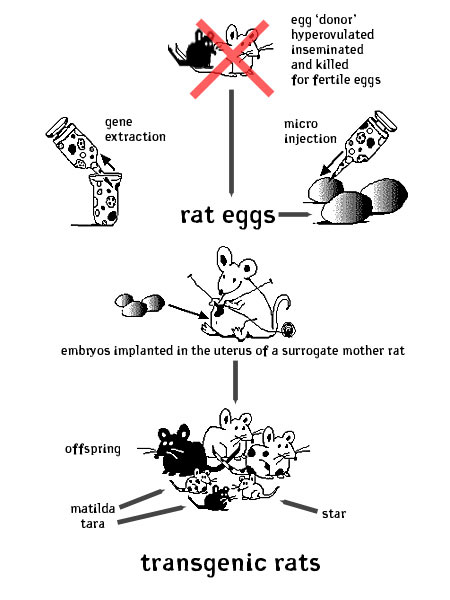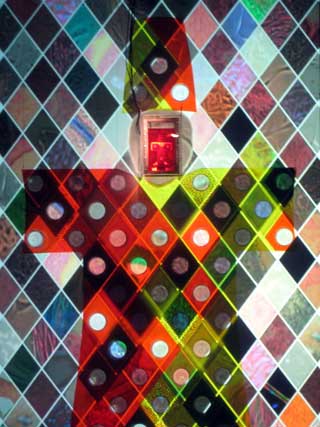Kathy High, the Associate Professor of Department of Arts of Rensselaer Polytechnic Institute is one of them. Like many other artists, she makes rat as her friend. Technologically, this small animal is close relative to humans in tree of revolution; morally and historically, its nocturnal habits and notorous name as a pest makes it easier for human beings to accept the "scary" experiment on it. Kathy inserted foreign DNA into regular rats. Therefore, some non-rat features have been displayed on its offsprings, which is called the transgenic rats.
The choice of gene are chosen by human, depending on the goal of the experiment. For example, In the picture above, rats could release many eggs, which would never happen on wild rats. Some others chose to give them fluorescent gene--Green fluorescent protein DNA, then the baby rats would become green under ultraviolet light, this was done by researchers in University of Pennsylvania.
Photograph courtesy University of Pennsylvania
Artists are not satisfied with applying this amazing science only to small animals like rats. The famous Harlequin Coat by French artist Orlan, composed by various skin from different color, age and sex, develops the idea of crossbreeding and hybridization. Afterwards, a questions rise to the public: can skins of different color be cultivated?
There are a lot more artworks combining biotechnology and art, like "the third eye" by Stelios Arcadiou. Seriously, I can't look at the picture for too long because such implanted "artwork" makes me sick. However, I'm not in the opposite position of their rights of doing so. Some critics blame this method are driving against the natural law. But I would argue that, as long as the nature makes it possible to do so, there is nothing "unnatural" of it. The biotechnology should definitely being controlled and tested carefully because of the unpredictable nature of the experiment. I would expect inspiring advances and amazing artworks to be created in the future, but I sincerely hope we treat it fairly and carefully.
Work Cited
Combs, Chris. "Glowing Animals: Beasts Shining for Science." Nationalgeographic.com. Nationalgeographic, 14 May 2009. Web. 9 Nov. 2013. <http://news.nationalgeographic.com/news/2009/05/photogalleries/glowing-animal-pictures/?rptregcta=reg_free_np&rptregcampaign=20131016_rw_membership_n1p_us_se_w#/rats-mice-glowing-animals_11838_600x450.jpg>.High, Kathy. "Embracing Animal :: All About Transgenic Rats." Embracing Animal :: All About Transgenic Rats. Embracinganimal.com, n.d. Web. 10 Nov. 2013. <http://www.embracinganimal.com/transrats.html>.
High, Kathy. "Kathy High: Visual/media Artist, Independent Curator, Educator." Kathy High: New Media Artist: Full Biography. Http://kathyhigh.com/, n.d. Web. 10 Nov. 2013. <http://kathyhigh.com/longbio.html>.
Orlan. "Bio-art." ORLAN OFFICIAL WEBSITE SITE OFFICIEL DORLAN RSS. ORLAN Studio, n.d. Web. 10 Nov. 2013. <http://www.orlan.eu/works/bio-art/>.
"Still, Living." Still, Living. SymbioticA, n.d. Web. 10 Nov. 2013. <http://www.stillliving.symbiotica.uwa.edu.au/pages/artists/orlan.htm>.



I agree with your opinion with the experiment of biology. I would also say that artists should not go beyond the limits without really knowing the results of the experiment. Art should be an endeavor, instead of random experiment. We all see the creativity that stems from utilizing biotechnology, but we also need to ponder the ethnical boundary of these artworks.
ReplyDelete